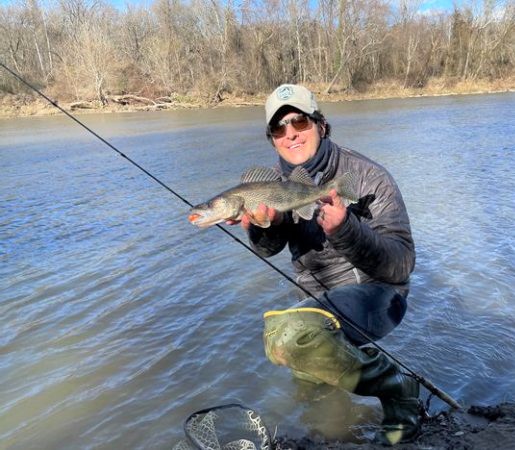
Each year in March, fisheries biologists and hatchery production staff collect adult walleye from the New River, Staunton River, and the South Holston Reservoir for the production of fingerling walleye to stock in selected lakes and rivers in Virginia.
Walleye were spawned or hatched at Vic Thomas, Front Royal, King and Queen, and Buller fish cultural stations and were raised in ponds until they were about 1.5 inches long when they were stocked in locations across the state. Additionally, female walleye are crossed with male sauger to produce the hybrid saugeye. Saugeye perform well in some systems and are stocked with or in place of walleye. In 2020, the Virginia Department of Wildlife Resources stocked approximately 1,025,283 Walleye fingerlings.
Overall, 2020 was a good production year slightly above the long-term annual production average for the past decade of 890,852 fingerlings statewide.
The following report offers walleye sampling results and fishing forecasts on waters stocked with walleye and saugeye fingerlings. Anglers who want the challenge of catching a walleye or saugeye should fish one of the locations in this forecast.
In 2021, walleye fishing on the Upper New River from Buck Dam downstream to Allisonia will be consistent with recent years due to annual stocking since 2014. In 2015 and 2017 to 2020, walleye were stocked at multiple sites from Allisonia to Fries. As a result, annual walleye catch rates in fisheries biologists’ spring electrofishing sampling increased from the low-catch rates in 2014 and 2015.
Anglers fishing from Buck Dam to Claytor Dam will have to release 19- to 28-inch walleye year round under the new size limit effective January 1, 2021, but they should catch plenty of walleye under 19 inches. In spring 2020 electrofishing samples, 58% of the walleye collected were in the 14-to 19-inch size range.
When you fish for walleye on the Upper New River, follow these size and creel limits: 1. From Buck Dam downstream to Claytor Lake Dam: Year-round: All walleye 19 to 28 inches caught must be released unharmed. Anglers may keep two walleye per day less than 19 inches or over 28 inches. This regulation allows anglers to harvest a few smaller male walleyes (typically less than 19 inches) or a trophy female walleye (typically greater than 28 inches) while protecting the best spawning-size walleyes in the population.
- From Fries Dam downstream to Buck Dam: As of January 1, 2021, the statewide 18-inch minimum length limit, with a five-per-day creel limit for walleye is in effect year-round. Biologists tagged walleye in the Upper New River from 2008 to 2012 as part of a statewide walleye research project. A cash reward of 20 dollars will still be offered for the return of these tags with catch information.
Anglers can remove the tag by cutting through the monofilament attachment with scissors or a knife. The fish can then be released or harvested (the length limits listed above apply). Return the tag and catch information to the address printed on the tag. Catch information includes date, time and general location of catch, and “Was the fish harvested or released? Were you fishing for walleye?” and “Did you catch other walleye on this fishing trip?”
Anglers visiting South Holston Lake in 2021 should experience good Walleye fishing although not as productive as in recent years. Sampling during 2020, including both electrofishing and gillnetting, exhibited a decline in catch, although a mostly desirable size structure remains with most walleye collected during the fall gillnetting larger than 18 inches.
Winter gillnet surveys provide a more complete picture of the walleye population at South Holston Lake in terms of population densities, growth rates, and survival of stocked fingerlings. A reduced stocking in 2016 of 42,640 Walleye fingerlings due to hatchery production issues has resulted in a missing year class, which is now evident in our sampling efforts.
As a result, anglers should still enjoy the current state of the fishery, and more recent stockings at the requested allocation will increase the population that recruits to the fishery over the next few years.
Anglers can expect average fishing during the spring spawning run on the South Fork Holston River due to a reduced lake population. Anglers congregate near the community of Alvarado from February through April to catch walleye on the spring spawning run.
During May and June anglers find Walleye feeding along the shorelines of the lake. The post spawn top water bite in the lower lake will yield the best Walleye fishing Virginia has to offer. Walleye growth is outstanding, so anglers should find plenty of fish larger than the minimum size of 18 inches. Most Walleye exceed 10 inches in their first year and measure 15 to 18 inches in their second year. Walleye generally reach 20 inches by their third year.
This 108-acre lake provides anglers with a great opportunity to catch Walleye in a small lake setting. Located in Hungry Mother State Park, the lake is also a great destination for families.
The Walleye population is stable or slightly increasing. There are good numbers of fish up to 20 inches and just enough larger ones to cause anglers to lose some sleep this summer. Walleye up to 28 inches in length have been landed in recent years. April, May, and June are the three best months with night fishing generally being more productive. Most anglers use artificial lures, but live shad, minnows, and night crawlers are also very effective.



